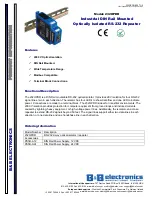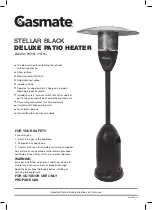
11
1.4.3 Electrical
Connections
The wiring to the Vapac should be done by a
qualified electrician. The external overcurrent
protection and wiring should comply with the
appropriate Regulations and Codes of Practice
.
Important:
Make sure the connection to the primary
Voltage winding of the Vapac transformer matches
the supply Voltage which is to be connected
between Vapac terminals A1 & A2.If the actual
(measured) site voltage is 400v the preferred
tapping is 380V
.
A fused disconnect/isolator or MCB should be used
to disconnect the supply from all electrodes
simultaneously.
This must be sized to suit the total maximum
phase/line current of the unit and should be located
adjacent to the Vapac cabinet or within easy reach
and readily accessible.
In Vapac VAPANET units terminals 1, 2 and 3 are
for the power supply connections as indicated in the
diagrams below.
Twin cylinder units’ have terminals for the
connection of two power supply input circuits. On
twin cylinder units’ this allows individual external
protection of each steam cylinder. Fused
disconnect/isolator or MCB provision must be linked
to ensure both 3 phase supply inputs are
disconnected simultaneously.
1.4.4 Cable
Entry
Provision
Cable glands must be used to ensure cables are
held securely at the entry position. All Vapac
cabinets are equipped with a removable gland-plate.
The installing electrician should remove this and
take it to a work-bench to drill for the required cable
gland size.
1.4.5
Vapac Control Circuit Transformer
The internal control circuit of the Vapac unit
operates at 24Vac - the transformer secondary is
set at 24V.
As standard the Vapac VAPANET includes a
transformer with alternative primary winding options
200V, 230, 380, 415, and 440V and requires on site
adjustment to match it to the Voltage connected to
Vapac terminals A1 and A2.
The transformer also has a 9V secondary tapping
which
provides power to the VAPANET 1150630
PCB.
Important:
The Vapac transformer must
NOT
be
used to power other equipment or the warranty will
be invalidated.
1.4.6 RDU
Connection
Vapac terminals 25 & 26 are included to provide a
230Vac electrical supply for the fan motor in the
RDU (Room Distribution Unit) .
Note: The 230Vac at terminals is derived from the
incoming electrical supply to the Vapac. If the local
supply cannot provide 230Vac (example 400V No
Neutral supply) it will be necessary for a transformer
to be fitted in the RDU as indicated below.
Notes:-
1. All units must have a PE earth connection connected to the units terminal.
2.
Unit with N.A. in the following tables means NOT AVAILABLE there is not a unit available to run at the voltage
and phases shown. Please check that the correct model reference is ordered and installed, for the low or high
voltage required, and at the desired steam output.
3.
Standard design is for 50 Hz. Supplies. Design for 60 Hz. Also available - 60 Hz. Supply must be specified with
order as the standard pump is only 50Hz.
TRANSFORMER
PRIMARY
380 – 440 V
SECONDARY
210 – 250
V
FOR FULL ELECTRO-MAGNETIC COMPATIBILITY A NEUTRAL CONNECTION IS REQUIRED FOR ALL
PROPORTIONAL UNITS AS INDICATED IN THE CONNECTION DIAGRAMS ON THE FOLLOWING PAGES.
RDU Connection
The three type’s of RDU are for various voltages and phase without neutrals connections that can be made to the Microvap unit. Please refer
to the Microvap connection diagram on the following three pages as to which type of unit is required. On twin cylinder units two fan circuits as
shown below one for each cylinder will be in the RDU unit.
RDU electrical load
Model RDU05LR
RDU09LR
RDU20LR
RDU30L
Number
of
fans
2 3 3 5
Fan voltage
230 v
230 v
230 v
230v
Each fan current 50Hz (60 Hz)
115 mA (105 mA)
115 mA (105 mA)
115 mA (105 mA)
115 mA (105 mA)
RDU total load current 50Hz (60 Hz)
225 mA (210 mA)
345 mA (315 mA)
345 mA (315 mA)
575 mA (525 mA)
200 – 250 V 1Ph. N + earth
200 – 250 V 2Ph. + earth
380 – 440 V 2Ph + earth












































